Energy and Exergy Analyses of Rice Drying in a Novel Electric Stationary Bed Grain-Drying System with Internal Circulation of the Drying Medium
Abstract
:1. Introduction
2. Materials and Methods
2.1. Materials and Experiment Conditions
2.2. Experimental Apparatus
2.3. Energy and Exergy Analysis Principle
- (1)
- The drying medium and grains suffered no losses through leakage;
- (2)
- When the drying medium flowed inside the device, energy loss between components was included in total loss;
- (3)
- Changes in the kinetic energy and pressure of the drying medium were ignored in exergy analysis;
- (4)
- The initial grain temperature was regarded to be consistent with room temperature, and the temperature in the drying process was regarded as consistent with the hot air temperature.
2.3.1. Energy Analysis
2.3.2. Exergy Analysis
3. Results and Discussion
3.1. Effect of Drying-Medium Temperature on Exergy Efficiency of Drying Process
3.2. Effect of Air Velocity on Exergy Characteristics of Drying Process
3.3. Effect of Temperature of the Drying Medium on the Improvement Potential Rate and Sustainability Index of the Drying Process
3.4. Effect of AV on the IPR and SI of the Drying Process
4. Conclusions
- (1)
- For drying rice in an electric stationary bed with ICODM, when the AT was between 30 and 50 °C the energy efficiency of the drying process gradually increased, while exergy efficiency did not significantly change. When the AT was between 50 and 55 °C, the energy efficiency of the drying process barely changed, while the exergy efficiency gradually decreased. When the AT was between 30 and 55 °C, AV across the grain layer was 0.5 m/s, and the average EEE of the drying process was 48.27–72.17% and 40.27–71.07%, respectively, and increased with the drying temperature.
- (2)
- When the AV through the grain layer was 0.33–0.5 m/s and the AT was 40 °C, the EEE of the drying process first decreased and then increased; the average values were 39.79–73.9% and 49.66–71.04%, respectively, and decreased with the increase in AV.
- (3)
- When the AT was between 30 and 50 °C, the IPR of the drying process decreased gradually to between 4.1 and 8.5 J/s; however, the SI of the drying process did not significantly change, remaining between 1.9 and 2.7.
- (4)
- When the AV through the grain layer was 0.33–0.5 m/s, the IPR of the drying process first increased and then decreased, but the SI of the drying process first decreased and then increased. When the AV through the grain layer was lower than 0.43 m/s, the IPR of the drying process was low, while the SI was high.
5. Patents
Author Contributions
Funding
Data Availability Statement
Acknowledgments
Conflicts of Interest
References
- Tohidi, M.; Sadeghi, M.; Torki-Harchegani, M. Energy and quality aspects for fixed deep bed drying of paddy. Renew. Sustain. Energy Rev. 2017, 70, 519–528. [Google Scholar] [CrossRef]
- Zhang, D.Y. Discussion on energy saving and emission reduction of drying system. Che. Mach. 2009, 36, 195–199. [Google Scholar]
- Li, X.Q. Design and research of energy saving and environment protection type grain dryer. China Plant Eng. 2019, 2, 198–199. [Google Scholar]
- Patipat, T.; Pakamon, P.; Kajorndej, P.; Nakorn, T. Utilization of Biomass Energy in Drying of Glutinous Rice Crackers. Energy Procedia 2017, 138, 331–336. [Google Scholar]
- Gao, S.C.; Wang, D.H.; Zhao, X.G.; Lin, Z.M. Application and practice of rice husk granular fuel in grain drying system. Grain Processing 2018, 43, 26–27. [Google Scholar]
- Zhou, X.X.; Liu, L.; Fu, P.C.; Liu, F.; Zhang, J.Y.; Gu, S.Q.; Ding, Y.T. Effects of infrared radiation drying and heat pump drying combined with tempering on the quality of long-grain paddy rice. Int. J. Food Sci. Technol. 2018, 53, 2448–2456. [Google Scholar] [CrossRef]
- Yahya, M.; Fahmi, H.; Fudholi, A.; Sopian, K. Performance and economic analyses on solar-assisted heat pump fluidized bed dryer integrated with biomass furnace for rice drying. Sol. Energy 2018, 174, 1058–1067. [Google Scholar] [CrossRef]
- Yahya, M.; Fudholi, A.; Sopian, K. Energy and exergy analyses of solar-assisted fluidized bed drying integrated with biomass furnace. Renew. Energy 2017, 105, 22–29. [Google Scholar] [CrossRef]
- Ren, L.H. Demonstration construction of electric energy storage grain drying hot blast stove. Grain Processing 2017, 42, 60–61. [Google Scholar]
- Wu, W.F.; Wang, G.Y.; Han, F.; Meng, X.M.; Fu, D.P.; Xue, H.Y.; Zhang, Q.J.; Sun, C.H.; Chen, J. Energy-Saving Condensing, Circulating and Heating Batch Type Recirculating Grain Drying Device. C.N. Patent 208,943,774, 2019. [Google Scholar]
- Wang, G.Y.; Wu, W.F.; Qiao, F.X.; Fu, D.P.; Liu, Z.; Han, F. Research on an electric energy-saving grain drying system with internal circulation of the drying medium. J. Food Process Eng. 2020, 43, e13476. [Google Scholar] [CrossRef]
- Wu, W.F.; Fu, D.P.; Wang, G.Y.; Han, F.; Liu, Z.; Xu, Y.; Zhang, Y.Q.; Yue, Z.F. Condensation Heating Grain Drying Basic Test Device. C.N. Patent 212,030,056U, 2019. [Google Scholar]
- Zhang, J. Study on drying properties and kinetics of paddy. Master’s Thesis, Hefei University of Technology, Hefei, China, 2018. [Google Scholar]
- Li, C.J.; Li, B.; Huang, J.Y.; Li, C.Y. Energy and exergy analyses of a combined infrared radiation-counterflow circulation corn dryer. Appl. Sci. 2020, 10, 6289. [Google Scholar] [CrossRef]
- Silva, G.M.; Ferreira, A.G.; Coutinho, R.M. Energy and exergy analysis of the drying of corn grains. Renew. Energy 2021, 163, 1942–1950. [Google Scholar] [CrossRef]
- Li, B.; Li, C.J.; Huang, J.Y.; Li, C.Y. Exergoeconomic analysis of corn drying in a novel industrial drying system. Entropy 2020, 22, 689. [Google Scholar] [CrossRef]
- Wincy, W.B.; Edwin, M.; Sekhar, S.J. Exergetic evaluation of a biomass gasifier operated reversible flatbed dryer for paddy drying in parboiling process. Biomass Conv. Bioref. 2021, in press. [Google Scholar] [CrossRef]
- Islam, M.A.; Mondal, M.H.T.; Akhtaruzzaman, M.; Sheikh, M.A.M.; Islam, M.M.; Haque, A.; Sarker, M.S.H. Energy, exergy, and milling performance of parboiled paddy: An industrial LSU dryer. Dry. Technol. 2021, in press. [Google Scholar] [CrossRef]
- Zohrabi, S.; Seiiedlou, S.S.; Aghbashlo, M.; Scaar, H.; Mellmann, J. Enhancing the exergetic performance of a pilot-scale convective dryer by exhaust air recirculation. Dry. Technol. 2020, 38, 518–533. [Google Scholar] [CrossRef]
- James, C.; Kim, T.Y.; Jane, R. A review of exergy based optimization and control. Processes 2020, 8, 364. [Google Scholar] [CrossRef] [Green Version]
- Aghbashlo, M.; Mobli, H.; Rafiee, S.; Madadlou, A. A review on exergy analysis of drying processes and systems. Renew Sustain Energy Rev. 2013, 22, 1–22. [Google Scholar] [CrossRef]
- Khanali, M.; Aghbashlo, M.; Rafiee, S.; Jafari, A. Exgergetic performance assessment of plug flow fluidized bed drying process of rough rice. Int. J. Exergy 2013, 13, 387–408. [Google Scholar] [CrossRef]
- Beigi, M.; Tohidi, M.; Torki-Harchegani, M. Exergetic analysis of deep-bed drying of rough rice in a convective dryer. Energy 2017, 140, 374–382. [Google Scholar] [CrossRef]
- Yogendrasasidhar, D.; Setty, Y.P. Drying kinetics, exergy and energy analyses of Kodo millet grains and Fenugreek seeds using wall heated fluidized bed dryer. Energy 2018, 151, 799–811. [Google Scholar] [CrossRef]
- Pattanayak, B.; Mohapatra, S.S. Energy and exergy analyses of paddy drying process in a vertical fluidizes bed dryer. Int. J. Exergy 2019, 28, 113–125. [Google Scholar] [CrossRef]
- Sarker, M.S.H.; Ibrahim, M.N.; Aziz, N.A.; Punan, M.S. Energy and exergy analysis of industrial fluidized bed drying of paddy. Energy 2015, 84, 131–138. [Google Scholar] [CrossRef]
- Liu, G.W. Drying Equipment Design Manual; China Machine Press: Beijing, China, 2009; p. 71. [Google Scholar]
- Ondier, G.O.; Siebenmorgen, T.J.; Mauromoustakos, A. Low temperature, low-relative humidity drying of rough rice. J. Food Eng. 2010, 100, 545–550. [Google Scholar] [CrossRef]
- Li, C.Y. Exergy evaluation theory of hot air drying system for grains. Trans. Chin. Soc. Agric. Eng. 2012, 28, 1–6. [Google Scholar]
- Shao, Y.J.; Liu, D.B.; Xiao, J.M.; Zheng, G.Q. Principle and Construction of Grain Dryer; China Machine Press: Beijing, China, 1985; p. 71. [Google Scholar]
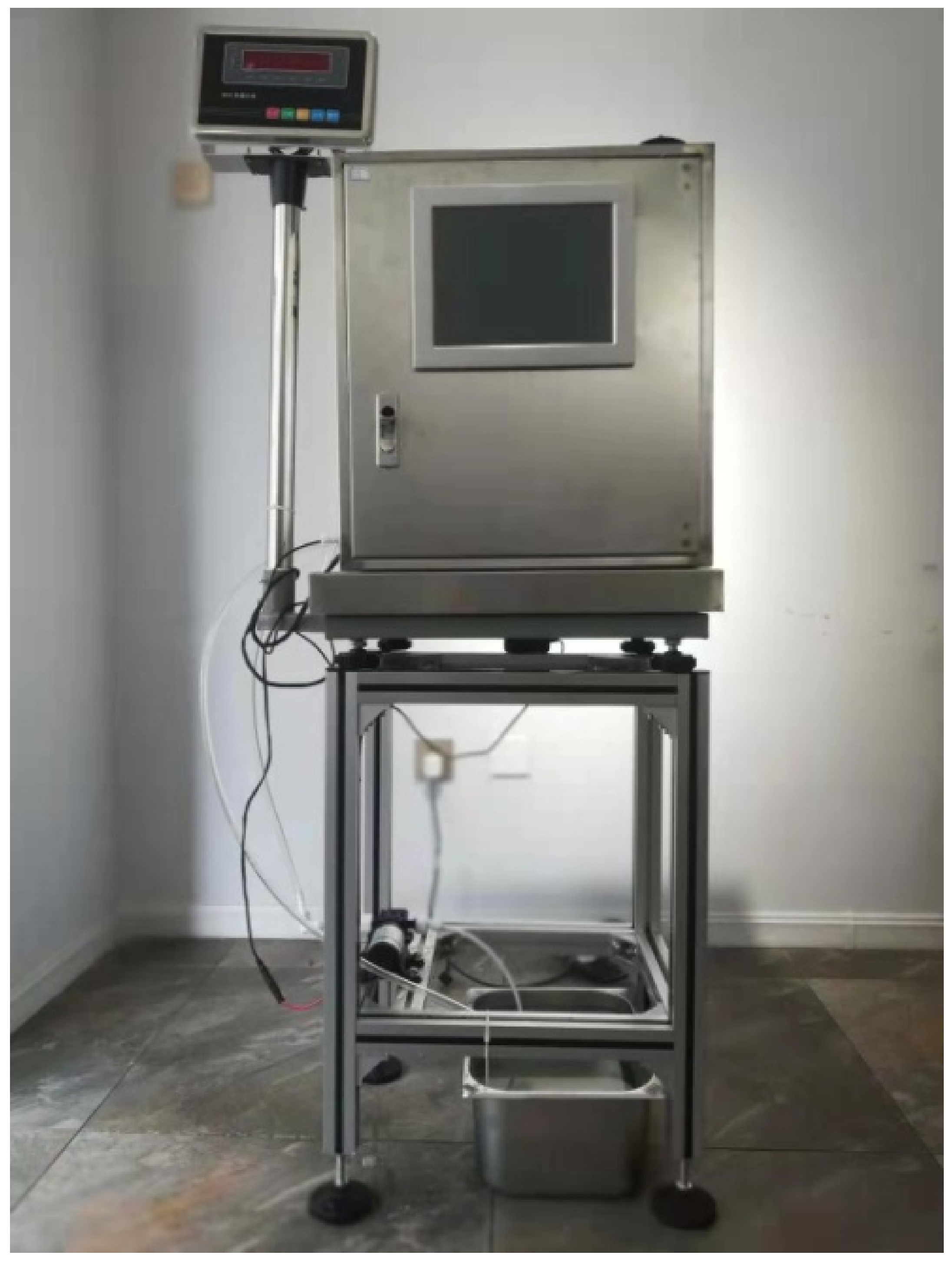
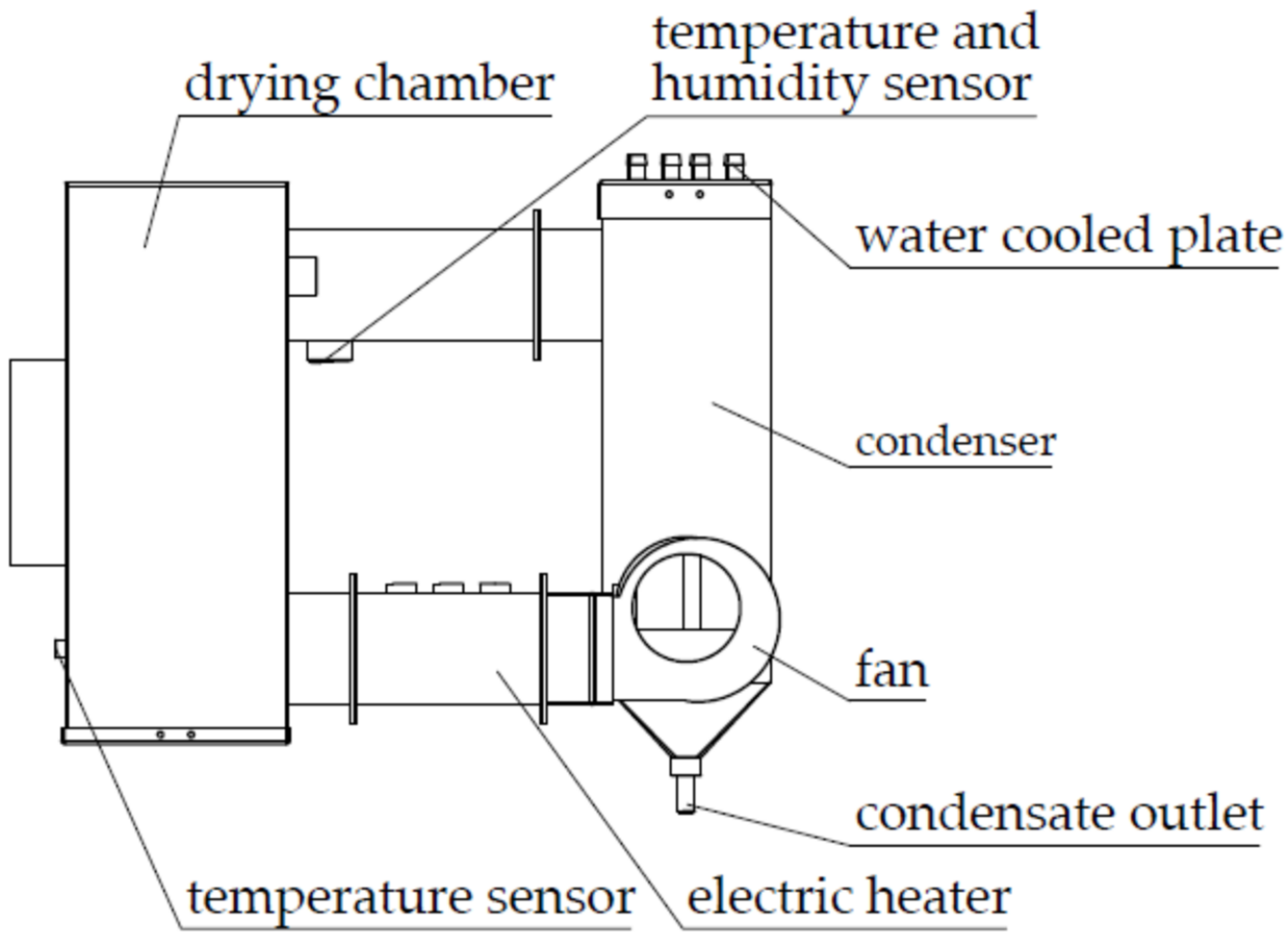
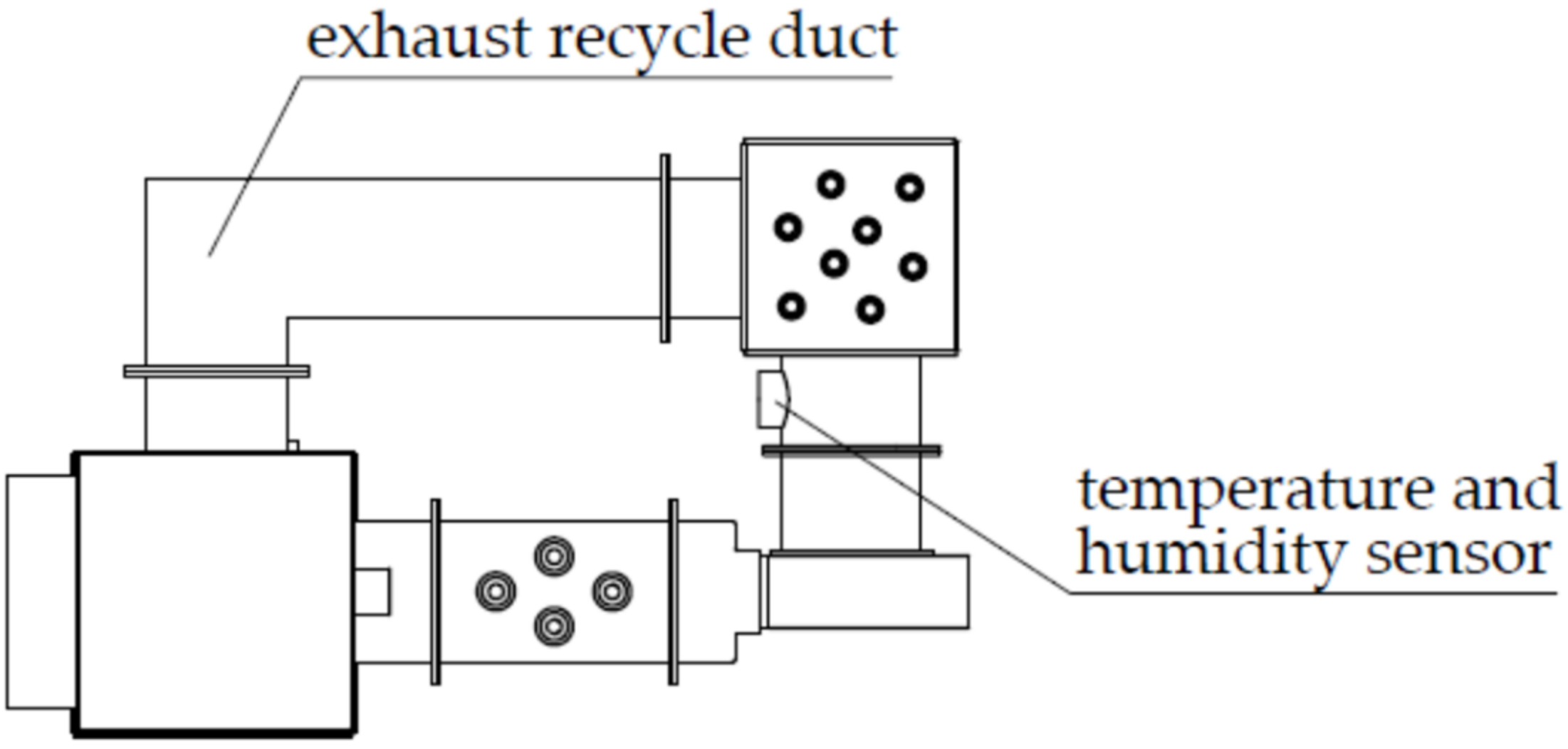
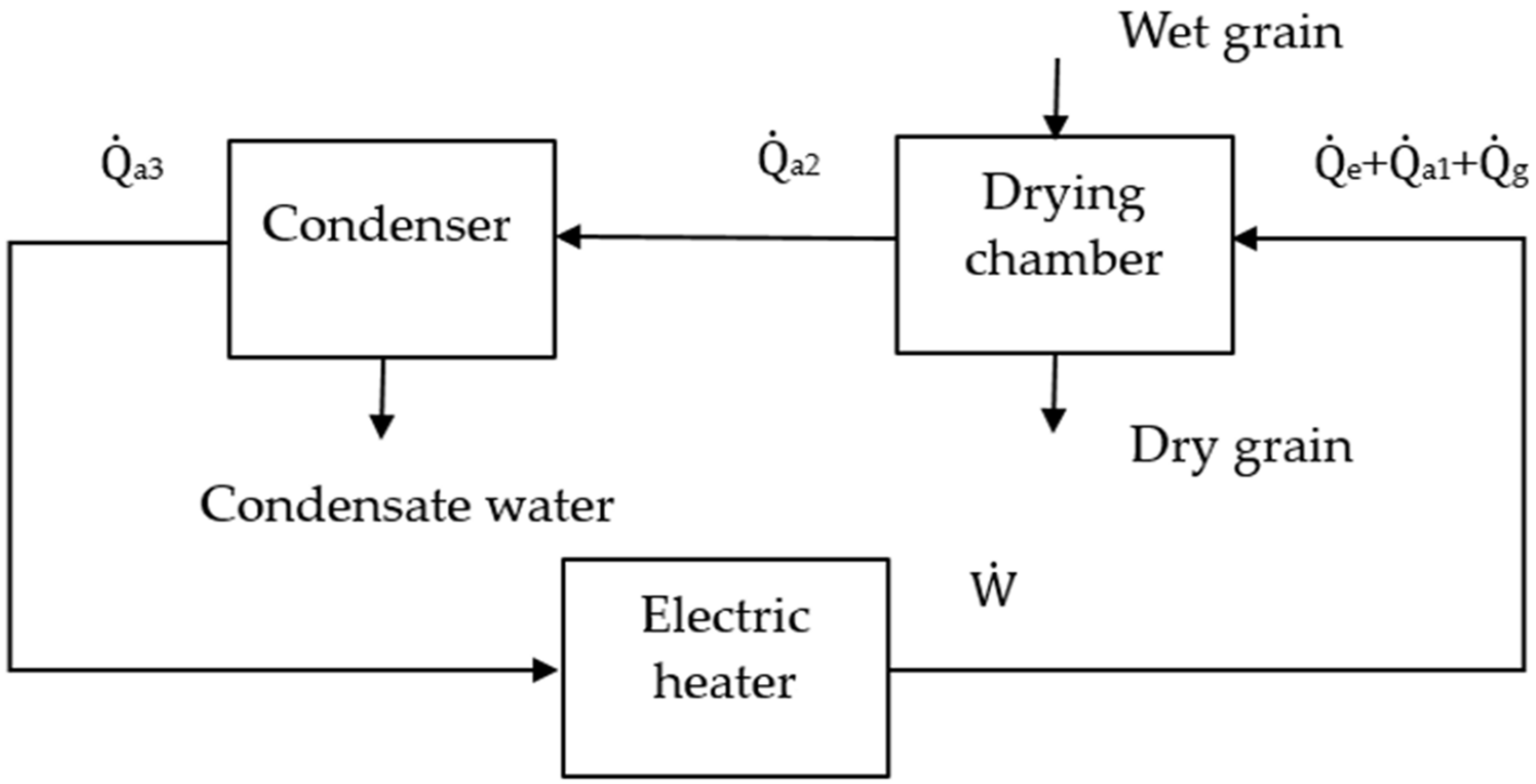

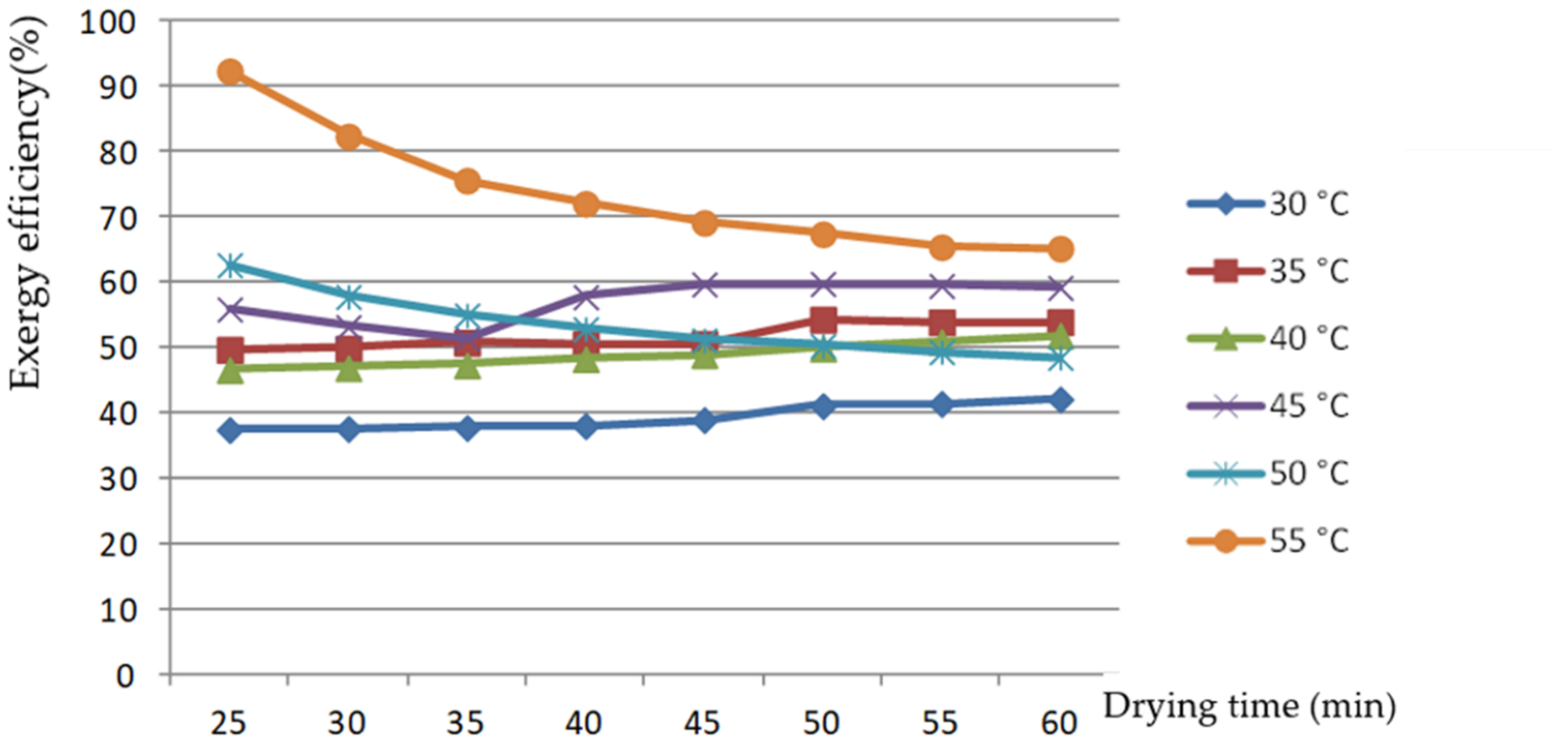
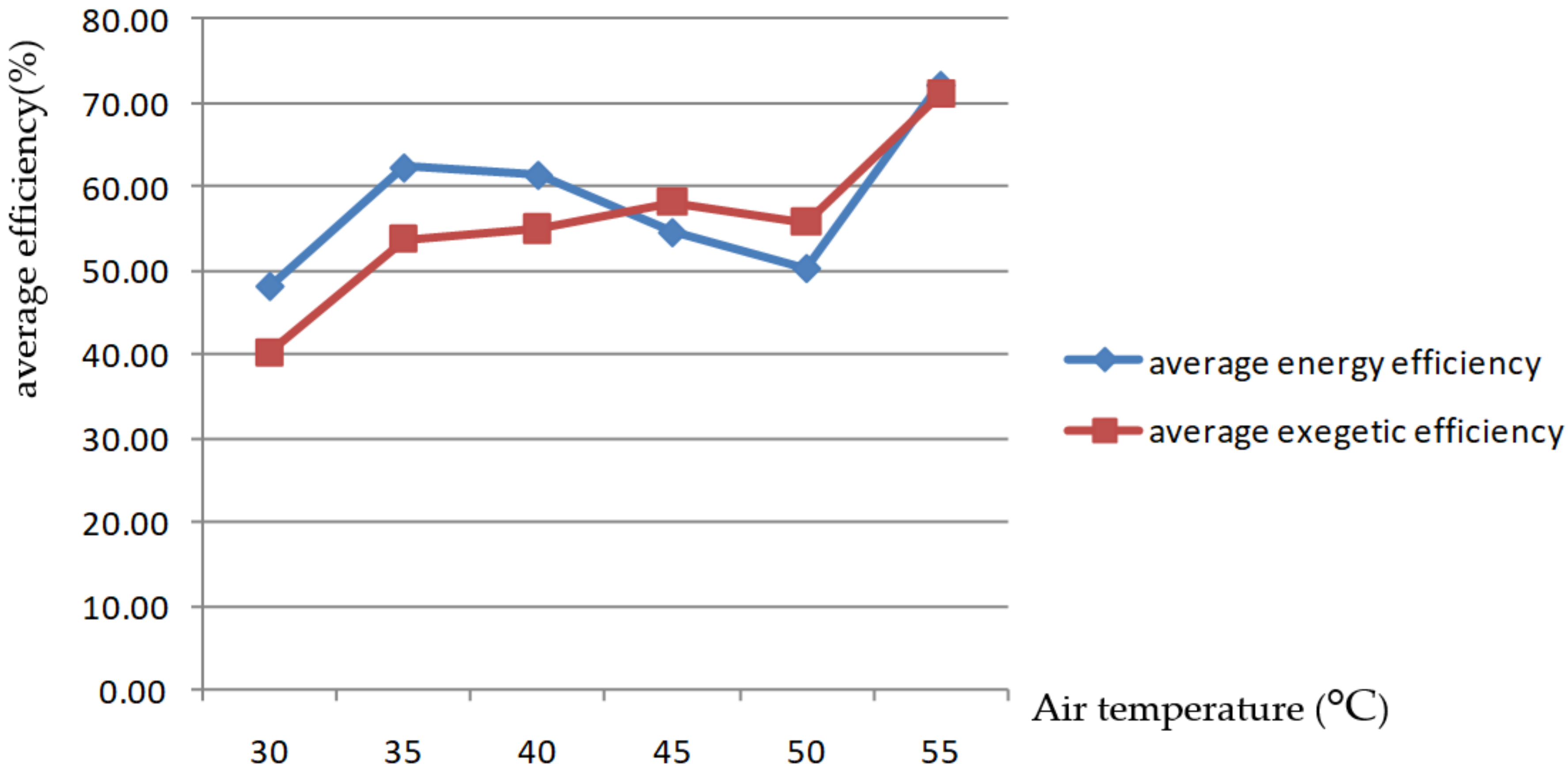
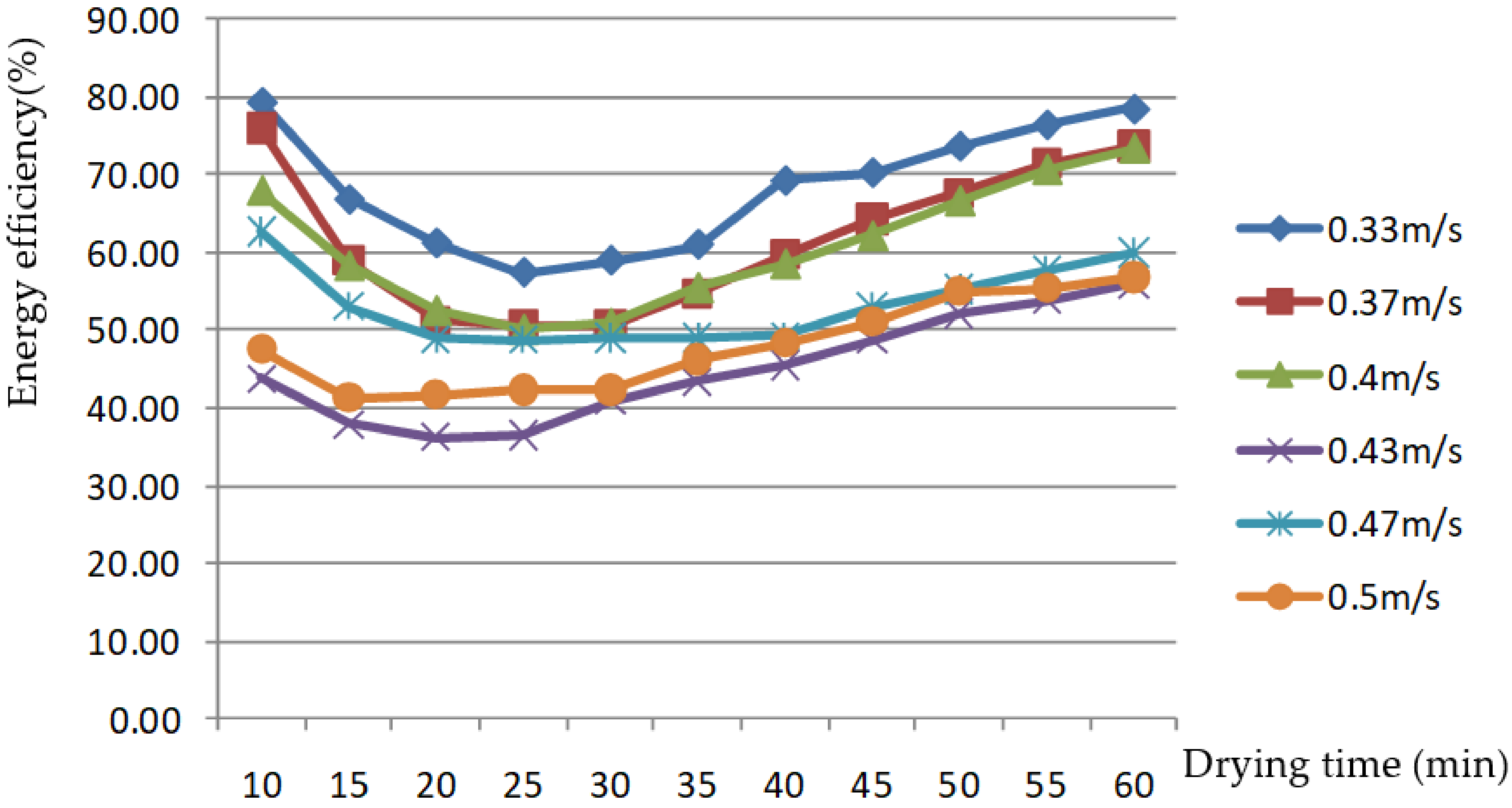
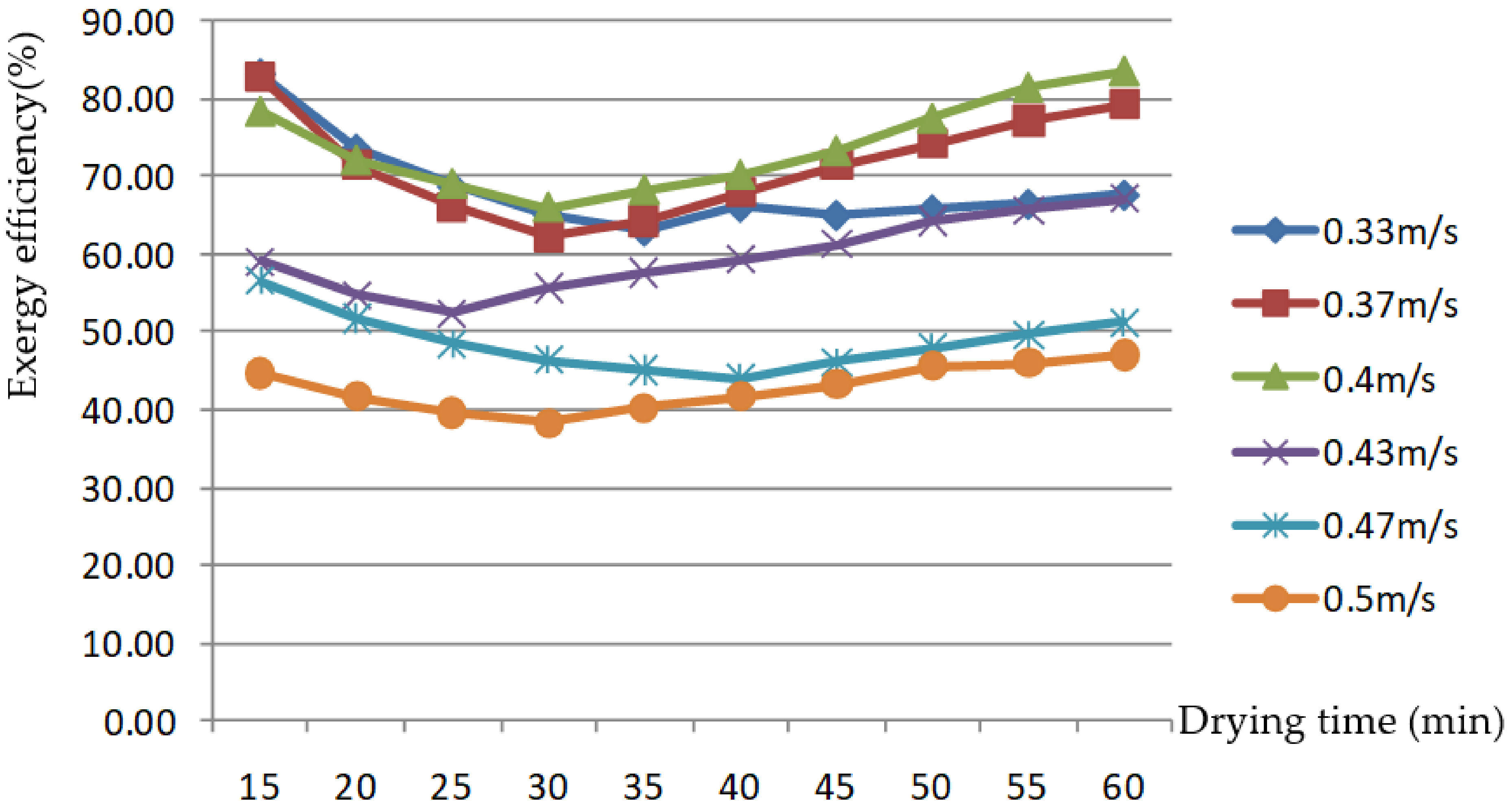
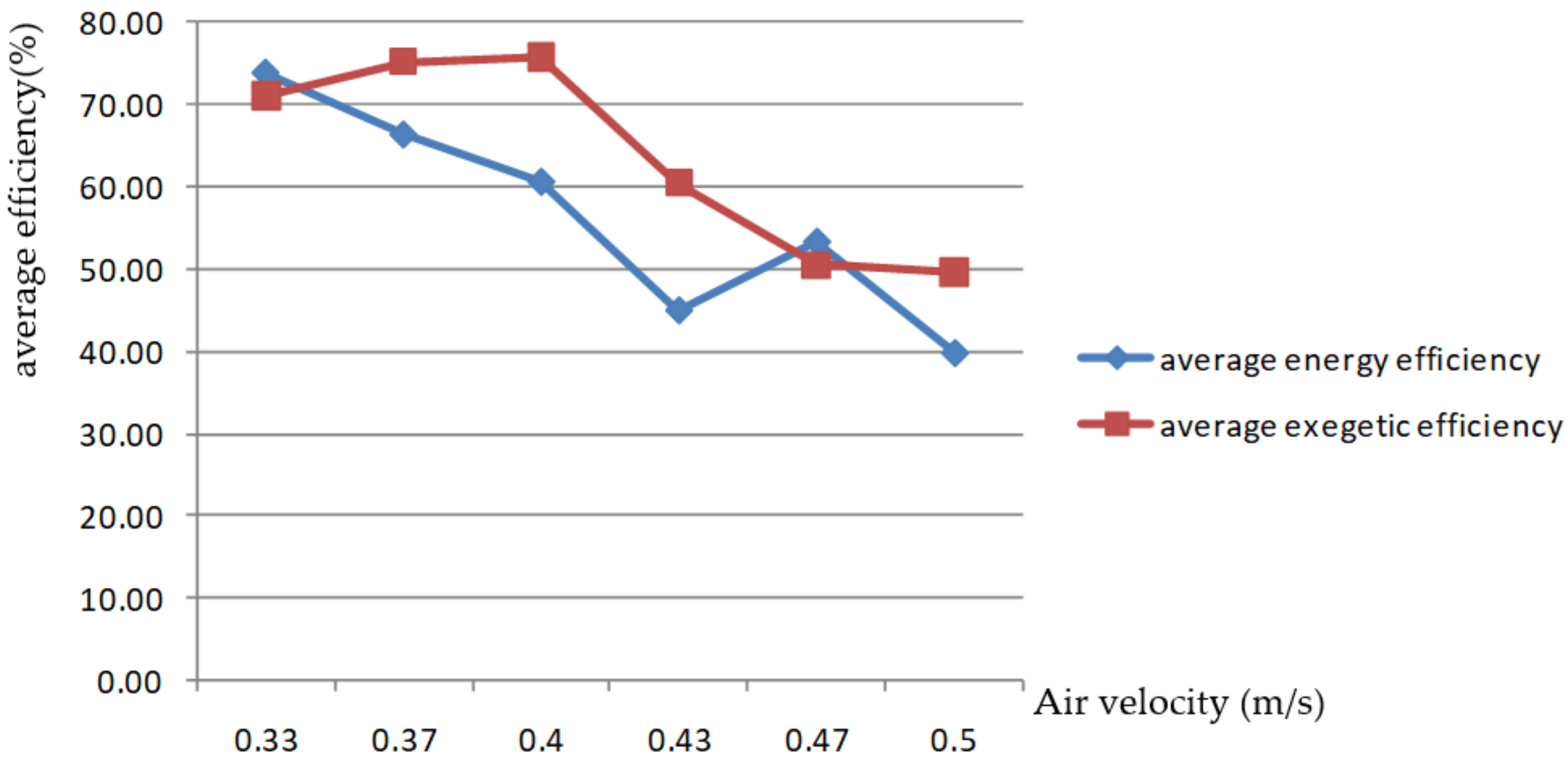
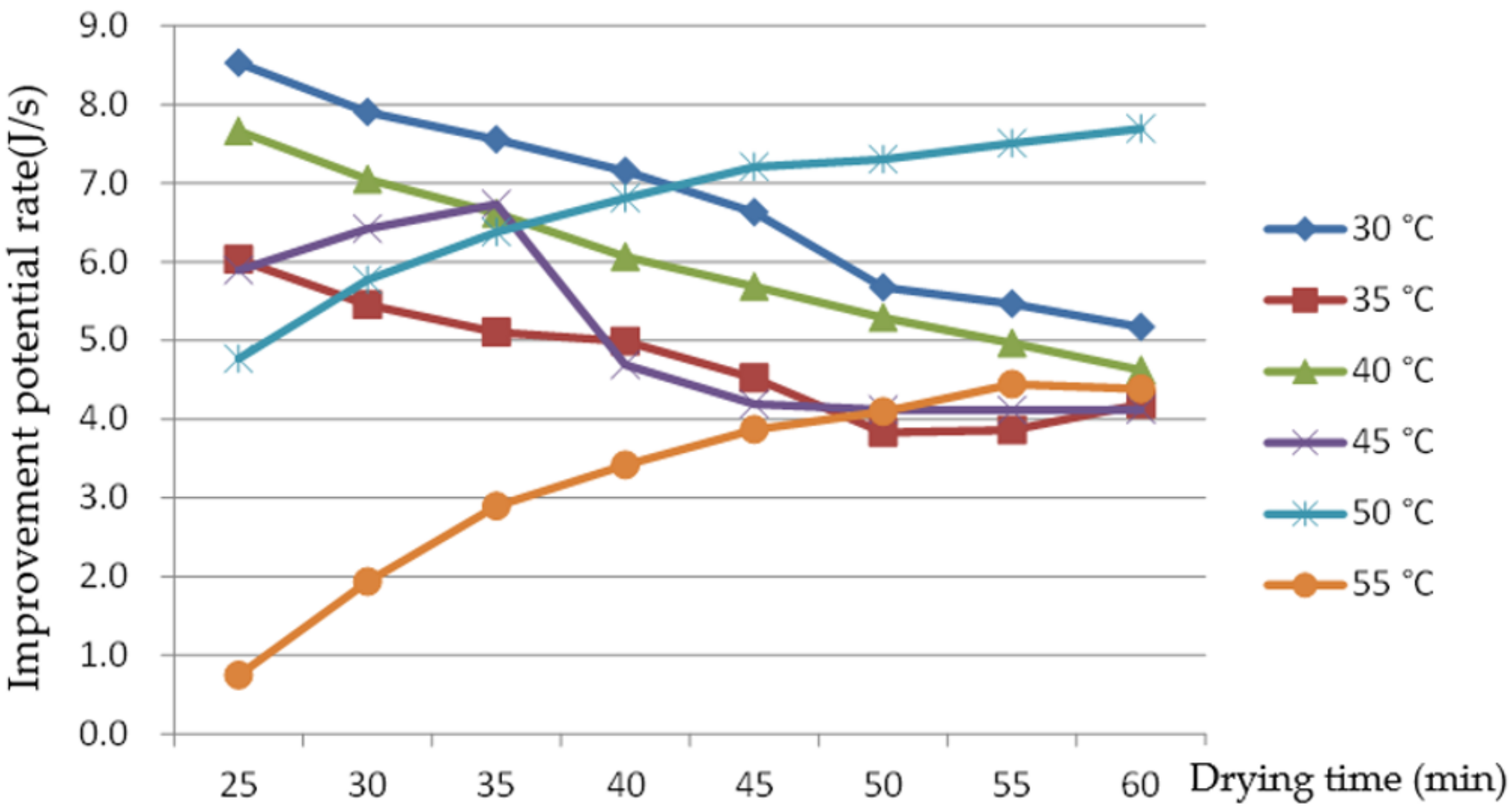
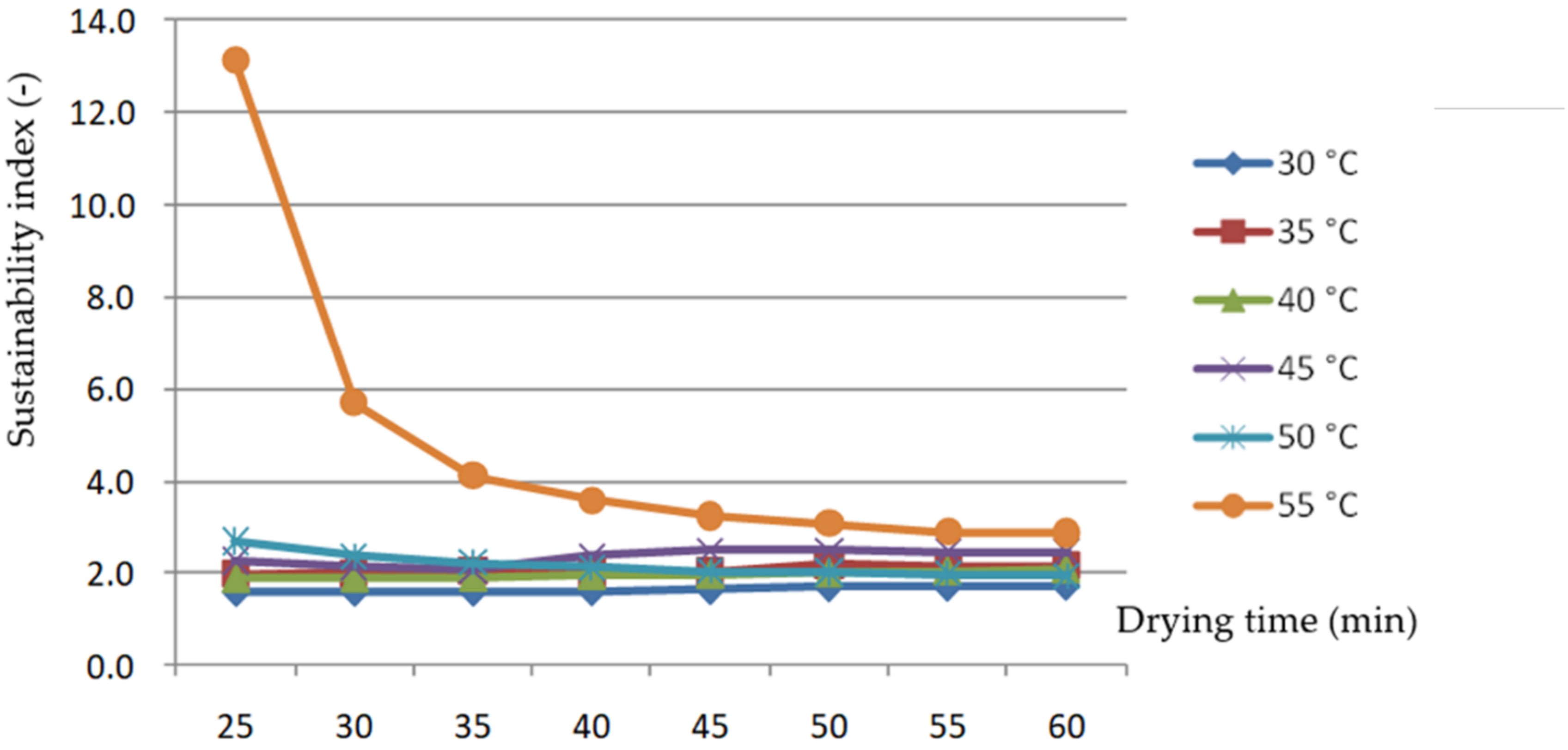
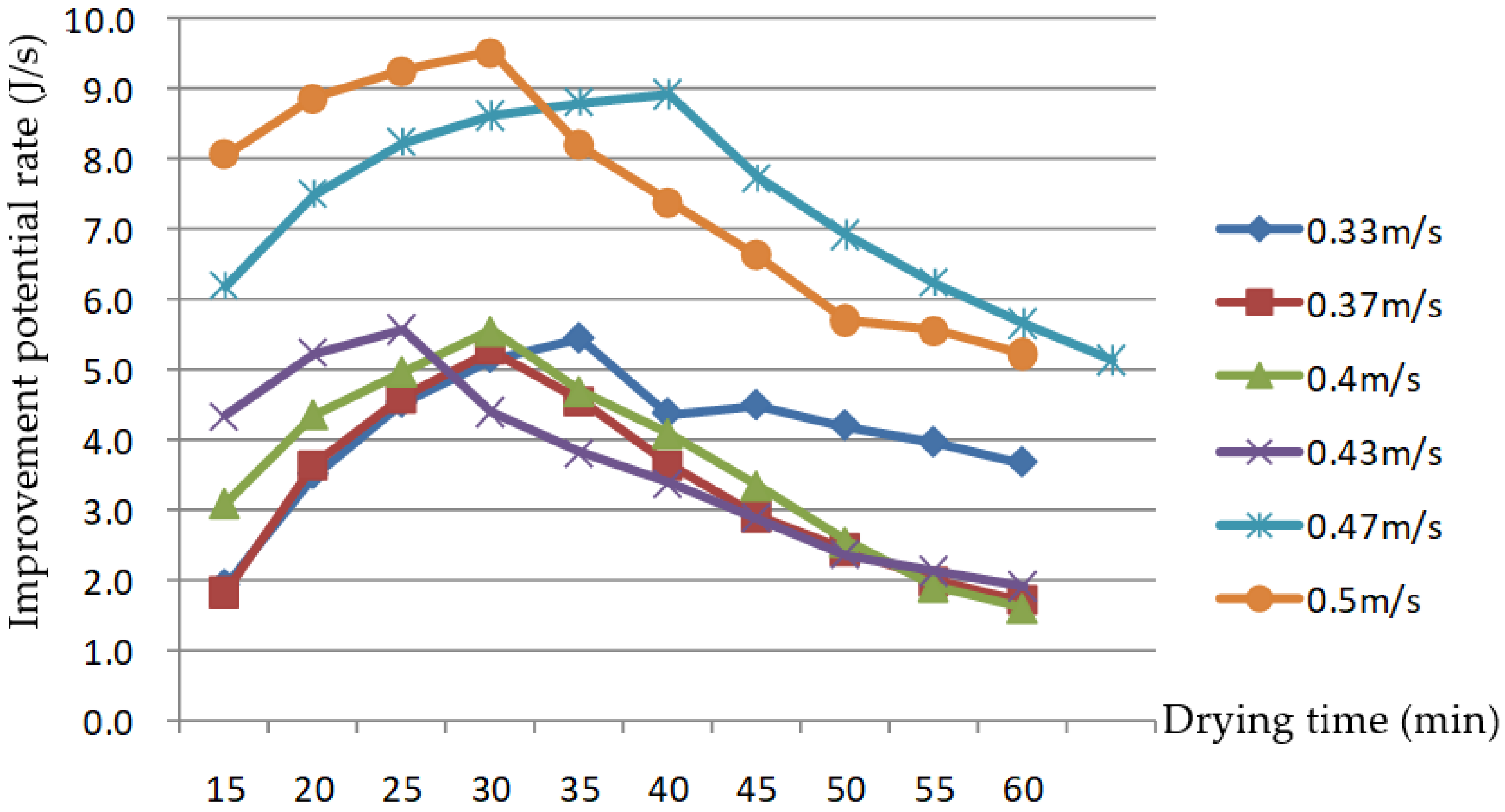
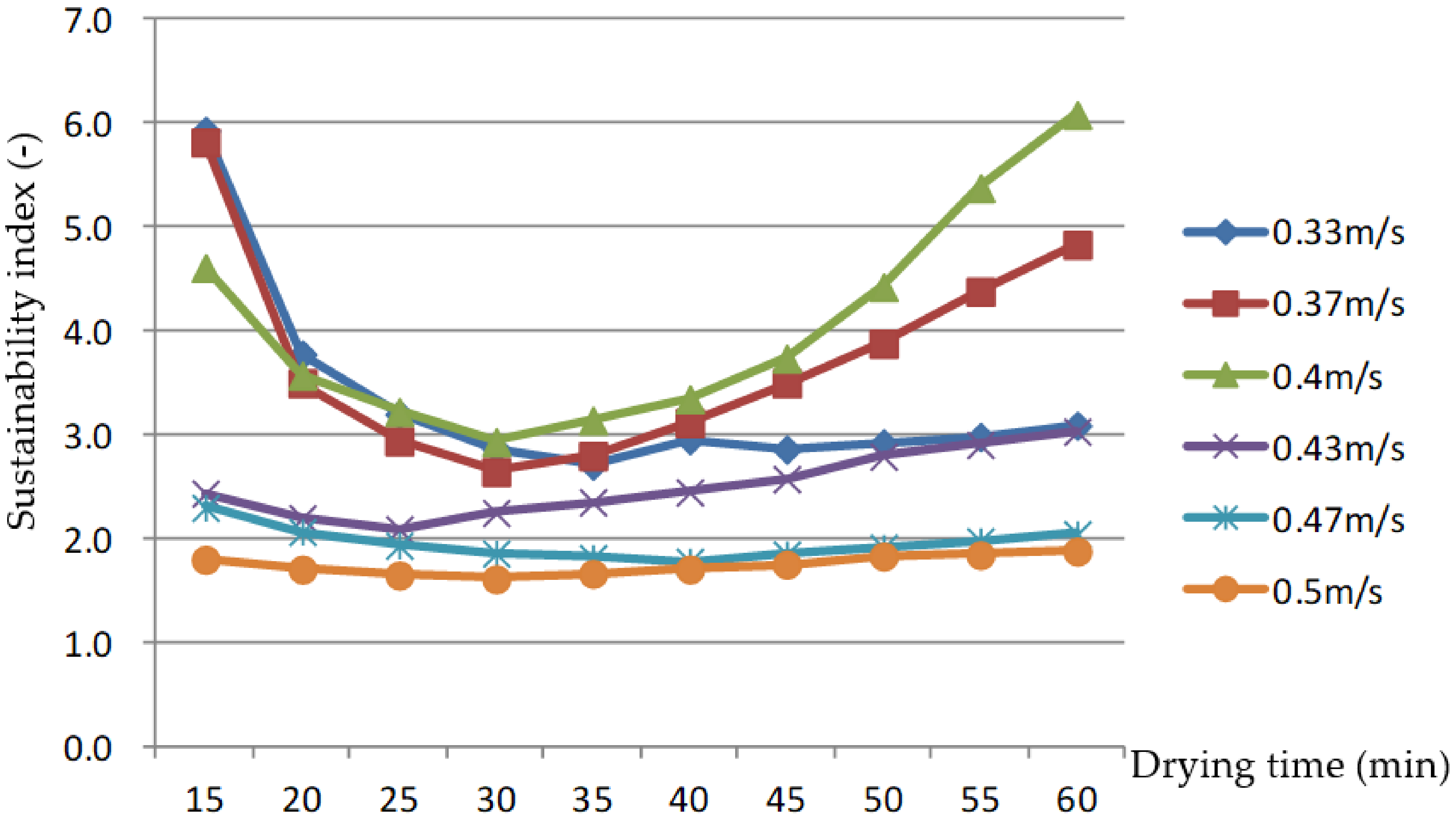
| Product | Drying Type | Process Variable | Conclusion | Reference |
|---|---|---|---|---|
| Rough rice | Laboratory-scale plug flow fluidized bed dryer | Inlet drying AT; feed mass flow rate; weir height | Exergy efficiency of drying chamber varied between 64.39 and 85.45% and increased with increase in drying AT and decrease in both feed mass flow rate and weir height. | [22] |
| Rough rice | Laboratory-scale convective dryer | Drying AT; AV | Exergy efficiency of drying chamber increased following the increase in both the drying AT and flow rate. | [23] |
| Kodo millet grains and fenugreek seeds | Wall heated fluidized bed dryer | Wall temperature; AV; bed height | Exergy efficiency increased with increasing wall temperature, AV, decreased with increasing bed height | [24] |
| Paddy | Vertical fluidized bed dryer | Drying AT; mass of paddy | Drying AV was 2 m/s; exergetic efficiency increased with increasing drying AT, while the converse was the case at 3 m/s | [25] |
| Paddy | Industrial fluidized bed | Drying AT; initial moisture content | During drying of a higher initial moisture content paddy of 23.66 ± 0.96%wb, energy usage and energy usage ratio increased and exergy efficiency decreased with higher drying AT of 116–125 °C when compared with drying at a comparatively lower initial moisture content (22.04 ± 0.35%wb) and using a lower drying temperature of 103–113 °C | [26] |
| Name | Model | Parameters Specification |
|---|---|---|
| Control of the host | PPC-DL104D | 10.4-inch industrial all-in-one machine |
| Aluminum water cooler | 40 × 240 mm | Thickness 12 mm |
| fan | BFB1012H | Air flow 0.712 m3/min, air pressure 249.082 Pa, motor speed 3600 rpm |
| Electric heating wire | 24v25w | _(There are no detailed specifications) |
| Detecting Parameter | Model | Range | Precision |
|---|---|---|---|
| Air temperature | PT100 | −100–280 °C | 0.1 °C |
| Temperature and humidity before and after exhaust condensation | HC2A-S | Humidity range: 0~100% RH Temperature range: −50~100 °C | ±0.8% RH/0.01 °C |
| Moisture content | PM-8188-A | 8.0–35.0% | 0.5% |
| weight | YHC | 30 kg | 1 g |
| Power meter | DDSU666 | _(There are no detailed specifications) | 0.001 kwh |
Publisher’s Note: MDPI stays neutral with regard to jurisdictional claims in published maps and institutional affiliations. |
© 2021 by the authors. Licensee MDPI, Basel, Switzerland. This article is an open access article distributed under the terms and conditions of the Creative Commons Attribution (CC BY) license (https://creativecommons.org/licenses/by/4.0/).
Share and Cite
Wang, G.; Wu, W.; Fu, D.; Xu, W.; Xu, Y.; Zhang, Y. Energy and Exergy Analyses of Rice Drying in a Novel Electric Stationary Bed Grain-Drying System with Internal Circulation of the Drying Medium. Foods 2022, 11, 101. https://doi.org/10.3390/foods11010101
Wang G, Wu W, Fu D, Xu W, Xu Y, Zhang Y. Energy and Exergy Analyses of Rice Drying in a Novel Electric Stationary Bed Grain-Drying System with Internal Circulation of the Drying Medium. Foods. 2022; 11(1):101. https://doi.org/10.3390/foods11010101
Chicago/Turabian StyleWang, Guiying, Wenfu Wu, Daping Fu, Wen Xu, Yan Xu, and Yaqiu Zhang. 2022. "Energy and Exergy Analyses of Rice Drying in a Novel Electric Stationary Bed Grain-Drying System with Internal Circulation of the Drying Medium" Foods 11, no. 1: 101. https://doi.org/10.3390/foods11010101
APA StyleWang, G., Wu, W., Fu, D., Xu, W., Xu, Y., & Zhang, Y. (2022). Energy and Exergy Analyses of Rice Drying in a Novel Electric Stationary Bed Grain-Drying System with Internal Circulation of the Drying Medium. Foods, 11(1), 101. https://doi.org/10.3390/foods11010101






